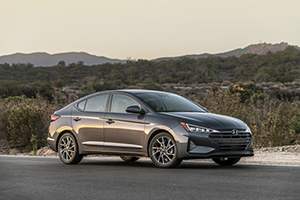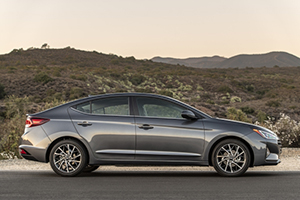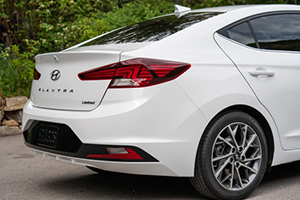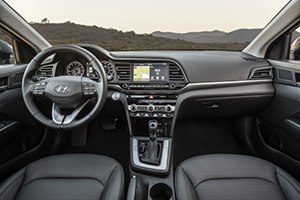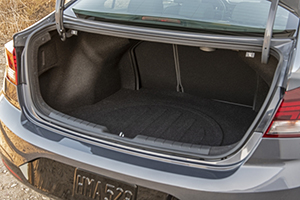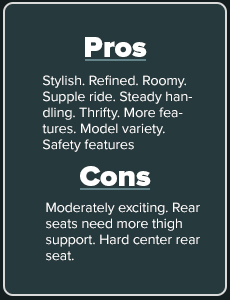2019 Hyundai Elantra Limited
sedan
The 2019 Hyundai Elantra
Limited gets new styling and more features
Price: $22,600
Hyundai has a lot to brag about with its 2019 Hyundai Elantra sedan,
which has a lot more going for it. The Elantra is Hyundai’s
top-selling vehicle, although it sells some fairly popular SUVs and
many automakers are dropping sedans in favor of SUVs.Now in its sixth
generation, the Elantra has sold more than 3 million units since its
launch in the U.S. in 1991.
For one thing, the 2019 Elantra has a new hood, front fenders, front
fascia, grille and headlights, along with new rear fascia with new
taillights, new 16- and 17-inch wheel designs and LED headlights on
some models. Even the license plates been relocated to the lower fascia
to further enhance the new body sculpture. Do you recall when the
Elantra was capable but dull-looking.
Hyundai didn’t stop with the outside styling. The quieter
interior has changes that give it a more upscale look.
There’s a new center cluster with easily read gauges and new
air vents, temperature controls, storage tray and a new instrument
cluster and housing. There’s also a standard 5-inch color
audio system, steering wheel audio controls, wireless charging,
available Android Auto and Apple lCarPlays, and a rearview
camera with “dynamic” guidelines so a driver
doesn’t, say, back into a vehicle when leaving a parking
spot. There’s also a push-button start that’s
partly hidden by the steering wheel rim.
Moreover, no Elantra trim level will break the bank. Prices range from
approximately $16,950 to $24,620.
There’s good interior room, although the rear seats could use
more thigh support, and the center of the rear seat is stiff.
It’s best to use the fold-down rear center armrest with its
dual cupholders.
The trunk is acceptably large and has a power lid that works
efficiently. The cargo area doesn’t call for you to crawl
over the bumper to reach the far end of it. Rear seat backs have trunk
releases and flip forward easily and sit flat to significantly increase
the cargo area.
The four-door front-drive Elantra sedan comes in variety of trim
levels: SE, SEL, Value Edition, Limited, Sport.and economy-minded Eco.
The Eco has only 128 horsepower four-cylinder but good torque, while
most others have a 2-liter dual-overhead-camshaft 147-horsepower
four-cylinder engine with dual continuous variable valve timing. A
turbocharged 1.6-liter engine with 201 horsepower also is offered.
Transmissions are a 6-speed automatic with an easily used manual shift
feature, a 6-speed manual and 7-speed dual-clutch.
These are carryover engines, and it’s mystery to me why
Hyundai doesn’t bump the horsepower rating from 147 to at
least 150 horsepower. It wouldn’t make much
difference in performance but the higher figure just looks better.
The 147-horsepower four provides decent performance in town and during
passing on highways, partly because the car only weighs approximately
2,800 pounds, while delivering an estimated 28 miles per gallon in the
city and 37 on highways with 87-octane fuel.
Those who want more lively acceleration should opt for the 201
horsepower turbo engine, but it’s not really necessary for
most Elantra buyers. The Elantra Limited has a console switch for
Normal, Smart and Sport driving modes. Smart selects the proper driving
mode between Normal and Sport by judging driver
habits—“economical” or
“aggressive.” I found Normal mode to be fine for
most driving in typical Chicago area traffic and didn’t find
that the Smart mode did much anything. The Smart mode is best suited
for winding roads.
The ride is supple, although some sharp bumps can be felt. This is a
good long-distance car. The steering is precise but should provide more
road feel. Handling of my test car was composed in curves, thanks
partly to a nicely designed suspension and low-profile 45-series tires
on 17-inch alloy wheels. The brake pedal had a nice linear action, and
stopping distances with the anti-lock brakes were short. The Elantra is
no sports sedan, but always feels as if its on your
side.
I tested the 147-horsepower Elantra Limited with the 6-speed automatic.
It price sticker showed it listed at $22,600, but the bottom line of my
test car was $26,960 because it had the $3,350 Ultimate Package that
contains a power sunroof, navigation system, 8-inch easily used
touchscreen, power collision avoidance assist with pedestrian
detection, smart cruise control, 4.2-inch color TFT color instrument
cluster display and an $885 freight charge.
Not that the Limited doesn’t come without a bunch of stuff.
Features include a push-button start, easily read gauges, heated
leather seats, power driver’s seat, dual automatic
temperature control, wireless charging pad, steering wheel audio and
cruise controls, Infinity premium audio system with 8 speakers and a
fair amount of storage areas, including door storage pockets, covered
console bin, console storage tray and conveniently placed console
cupholders.
The Elantra Limited’s safety features included forward
collision avoidance assist, lane keep assist, blind spot collision
warning, rear cross traffic collision warning, front, front side
impact, side curtain and driver knee airbags, anti-lock brakes with
electronic brake force distribution and brake assist.
One of Hyundai’s smartest moves came when it began offering
its 10-year/100,000-mile powertrain warranty some years ago. Entering
spring, the nicely built, solid-feeling 2019 Elantra remains
Hyundai’s top seller despite increasing popularity of its
Santa Fe and Tucson SUVs.
